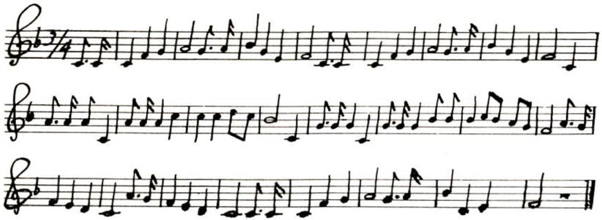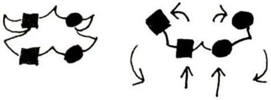
|
Folk Dance Federation of California, South, Inc.
|
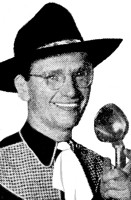 |
CLICK AN IMAGE TO ENLARGE
In common with most European countries today, the Netherlands have but little of the old folk customs, dress, and dances remaining in everyday use except for Marken Island (at least before World War II) where the people wear interesting old folk costumes as a stimulus to the tourist trade. Typical of this section are striped shirts and fine embroideries for the women and double rows of brass buttons down the front of the men's jackets.
The baggy trousers that have become a sort of Dutch trade mark in many people's minds were designed to allow the fishermen unencumbered movement in their work on the boats. The characteristic wooden shoes have just about vanished from the scene, even in post-war times . . . why? . . . Well, did you ever try to ride a bicycle in wooden shoes (called "sabots")? The windmills still decorate the landscape, however, being an essential part of the drainage system. Incidentally, most of them have names!
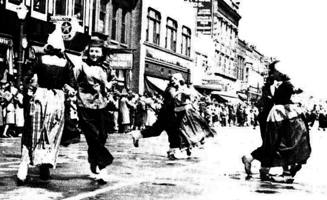 There were two chief periods in the migration of the Hollanders to this country; in the early 1600s, when Henry Hudson's discoveries were capitalized by the Dutch East India Company, and in the 19th century when, because of difficult conditions in the Netherlands, many sailed for New York.
There were two chief periods in the migration of the Hollanders to this country; in the early 1600s, when Henry Hudson's discoveries were capitalized by the Dutch East India Company, and in the 19th century when, because of difficult conditions in the Netherlands, many sailed for New York.
The early colonists had but a short existence as "New Netherlanders," because in 1674 the British took over the land grants. They respected the Dutch charter though, and the pioneers retained their lands in New Jersey, New York and Connecticut, forming the nucleus of the settlements in this area.
There is considerable literature of these early times; of their "Paas" (Easter) holidays with colored Easter eggs and "Killing Time" frolics in the Autumn when they danced and feasted on "rolletjes" (ground spiced meat sewed in tripe cases and boiled for a couple of days), "krullers" (a deep-fried pastry), "deuvekatjers" (apple doughnuts), and other delicacies. We have descriptions of bundling parties (they call them "geestings") following dances in taverns in Paramus and Acquackanonk, New Jersey, but very little usable description of the actual dances; that is, aside from the English adaptions which were very popular.
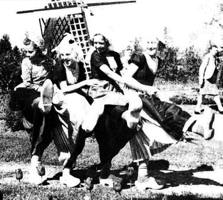 The few battered letters, flyleaf notations, etc. that I have found to have any step or music notations were certainly not written by formal dancing masters . . . one of my abashed translators assured me that one of the writers was "a very low person." At any rate, the bits that I scrapped together out of the scribblings have never been published in English before!
The few battered letters, flyleaf notations, etc. that I have found to have any step or music notations were certainly not written by formal dancing masters . . . one of my abashed translators assured me that one of the writers was "a very low person." At any rate, the bits that I scrapped together out of the scribblings have never been published in English before!
The 19th century migrants added to the early centers to some extent, but the majority settled in the Midwest, where today there are many "Dutch" communities, the largest being in Grand Rapids, Michigan. Annual Tulip Festivals are sponsored by two of these centers: Holland, Michigan, and Pella, Iowa.
To mention all the Netherlanders and their descendants who have achieved fame in the building of this country would take our whole issue.
For help in amassing our fund of information concerning the folklore, history, and dances upon which we shall draw again from time to time, we extend our thanks to local historical societies, many old Dutch families of Passaic and Bergen Counties, New Jersey, the Netherlands Information Bureau, the city of Holland, Michigan, the Utspanning Trock Ynspanning, the officials of a number of libraries, Mr. and Mrs. Kamena, and Mr. and Mrs. Langendoen.
The Dance Descriptions
Some of the old dances are preserved by festival organizations and folk societies.
Jan Pierewiet
A variation of the omnipresent Varsouvienne.
Formation: Man stands to the left and behind the lady, left hands joined, man's right hand extends behind lady, holding her right hand above her right shoulder.
1. Without releasing hands, turn toward partner to face back in the line of direction; point right toe and pause.
2. Repeat to face the other way.
3. Advance counterclockwise around the room with two mazurka steps; then turn inwards to face clockwise.
4. Advance clockwise with two mazurka steps and again turn inward.
5. One waltz step forward, girl turns to left hand.
6. All waltz.
Skater's Polka
Formation: Two couples inside hands joined with partner's, leading couple's outside hands held at their backs where they are joined with the outside hands of the following couple.
1. Imitating skaters in a polka step, all slide the left foot diagonally forward to the left, draw right foot to the left, again advance the left foot slightly.
2. Repeat to the right starting with the right foot.
3. Releasing inside hands and using the same slide polka step, the leading couple move around to position behind the second couple who at the same time advance two polka steps.
4. All advance four polka steps, starting left.
Repeat: Ad lib.
Lot is Dood
Formation: Couples face center, man's right hand joined to lady's left.
Country Shoes
Formation: Two couples facing.
1. Spring and extend right foot to the right heel on the ground.
2. Spring, changing feet, extending left foot to the lefty, heel on ground.
3. Spring, changing feet, extend right foot to the front, heel in ground.
4. Spring, changing feet, extending left foot to the front, heel on ground.
5. Bow to partner.
6. Bow to opposite lady.
7. Starting with left foot, turn completely around, counterclockwise, with three walking steps and hold up rightfoot to the center.
8. Start right foot turn clockwise and hold up left foot.
9. Right hand star.
10. Left hand star.
11. Four hands around to the left, chassez step.
12. Hands around the the right.
The Farmer
An imitative game. All start by walking to the right, single file, in a large circle, imitating the action of the farmer going to church. Reverse the direction of the circle with each new imitation. On the last verse (beats his wife), the tempo speeds up as all try to beat the back of the person ahead.
Reference
- "History of Patterson," by Nelson-Shriner.
- "Picture Story of Holland," by Doln DeJong (Reynal Hitchcock).
- "National Geographic," Jan 1915, Mar 1923, Sep 1929, Sep 1933, Feb 1940.
- "Oude Nederlandscke Volksdansen," W.J. Thieme & Co., Netherlands.
Printed in Rosin the Bow, Vol. 3 Number 2, Spring 1947.
